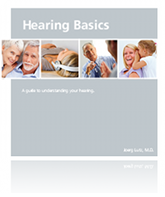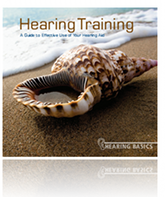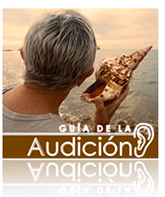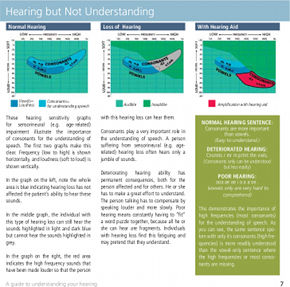HEARING BASICS
Hearing loss information for your patients
Realizing that one needs a hearing aid is the first hurdle.
The fact that one needs a hearing aid is not necessarily self obvious. Typically, hearing loss occurs very slowly, and it is the persons around the hearing challenged one who notice it first. Typically, it is difficult to make the affected person accept their handicap. The booklet Hearing Basics informs, among other crucial facts, about this first hurdle in a clear and concise explanation for why one may be the last to realize one's deteriorating hearing.
Hearing Basics familiarizes the reader in clear language and illustrations with the bewildering array of types of hearing aids, their pros and cons, the testing necessary before choosing and adapting a new hearing aid, along with the fundamentals of hearing. Reading the booklet Hearing Basics will help brook the hearing barrier between provider and potential clients, or patients.
Table of contents (Details +/-)
- Introduction
- Dedication
- Your Hearing Test
- The Ear – A Wonderful Organ
- Selected Types of Hearing Loss
- Hearing but Not Understanding
- Getting a Hearing Aid
- Inserting and Removing Your Hearing Aid
- The First Days with Your New Hearing Aid
- Hearing Loss in Both Ears/Batteries and Adjustments
- Helpful Hints with Your Hearing Aid
- Accessories and Communication Aids
- Hearing Accessories for All
- Tips for Speaking to Hearing Aid Wearers
- Hearing Problems in Children
- Hearing Aids for Children
- Checklist for Parents and Relatives
- Accessories and Communication Aids for Children
- Tinnitus
- Alternative Treatments for Hearing Aids
- Cochlear Implant
- Troubleshooting
Make it yours!
Put your own custom label inside the booklet or on the back cover where everyone will see it. Your office will be the first one considered when patients of an ENT decide to purchase hearing aids and your office will be the first one they recommend.
» See sample custom coversSample content from the book
Sensorineural Hearing Loss: Hearing loss that results from damage to the inner ear (cochlea), the nerve of hearing or both, is primarily experienced as a distortion of sound. Soft sounds are not heard and loud sounds are abnormally loud. Increases in volume do not typically solve the problem as distortion may remain. Hearing aids and assistive listening devices typically provide significant benefit.
Conductive Hearing Loss: Some conditions that affect the ear canal, the eardrum or the ossicles prevent sound from passing through the outer or middle ear to the inner ear (cochlea), which remains intact. In most cases, medical treatment is typically successful in improving the transmission of sound. Patients who do not want to undergo surgery may achieve significant benefit from the use of a hearing aid, as their primary need is amplification. Conductive loss may occur at any age and can occur suddenly or gradually.
Noise-induced Hearing Loss: The incidence of noise induced hearing loss is increasing as the world becomes noisier. It has been one of the most common occupational disabilities for some time. Noise exposure at work or during leisure time can permanently damage the inner ear. Only high frequency sounds are affected in the initial stages but lower frequencies are also affected with continued exposure to noise. Although this type of hearing loss can be prevented with the use of hearing protection devices, a hearing aid is the only treatment available once the damage has occurred.





